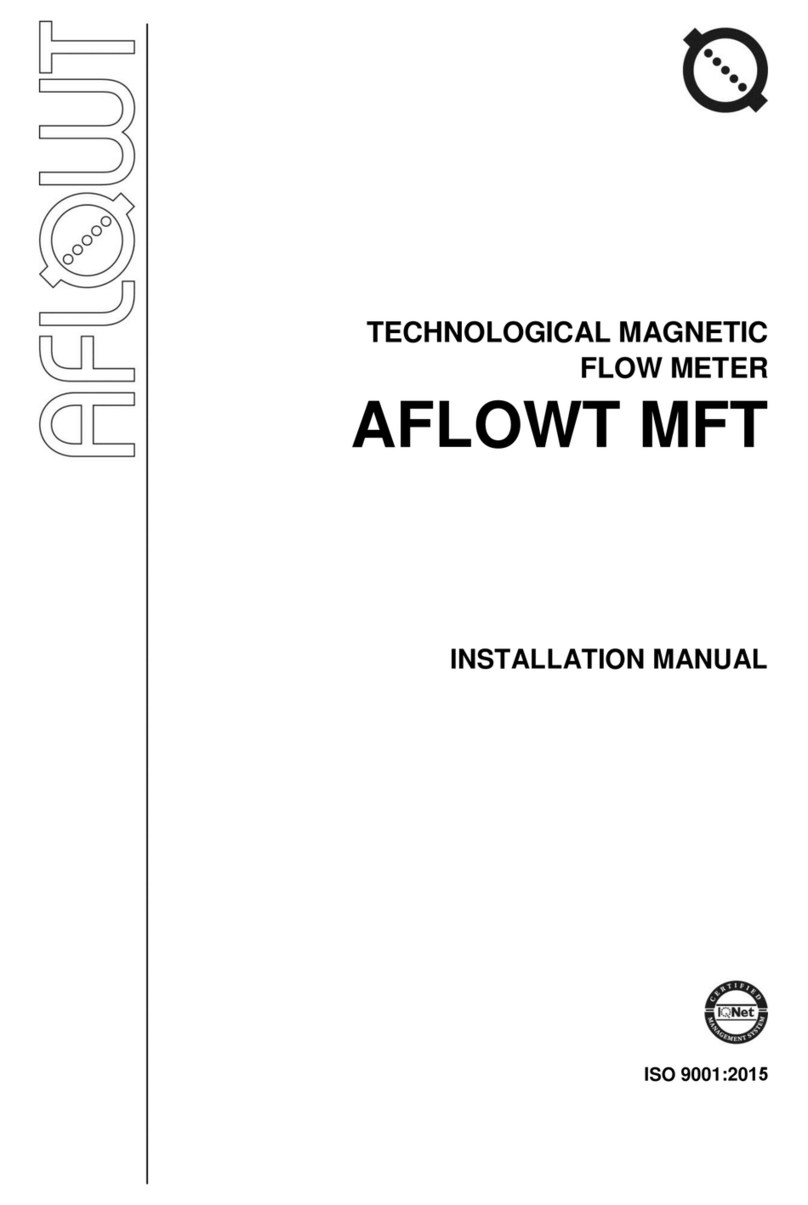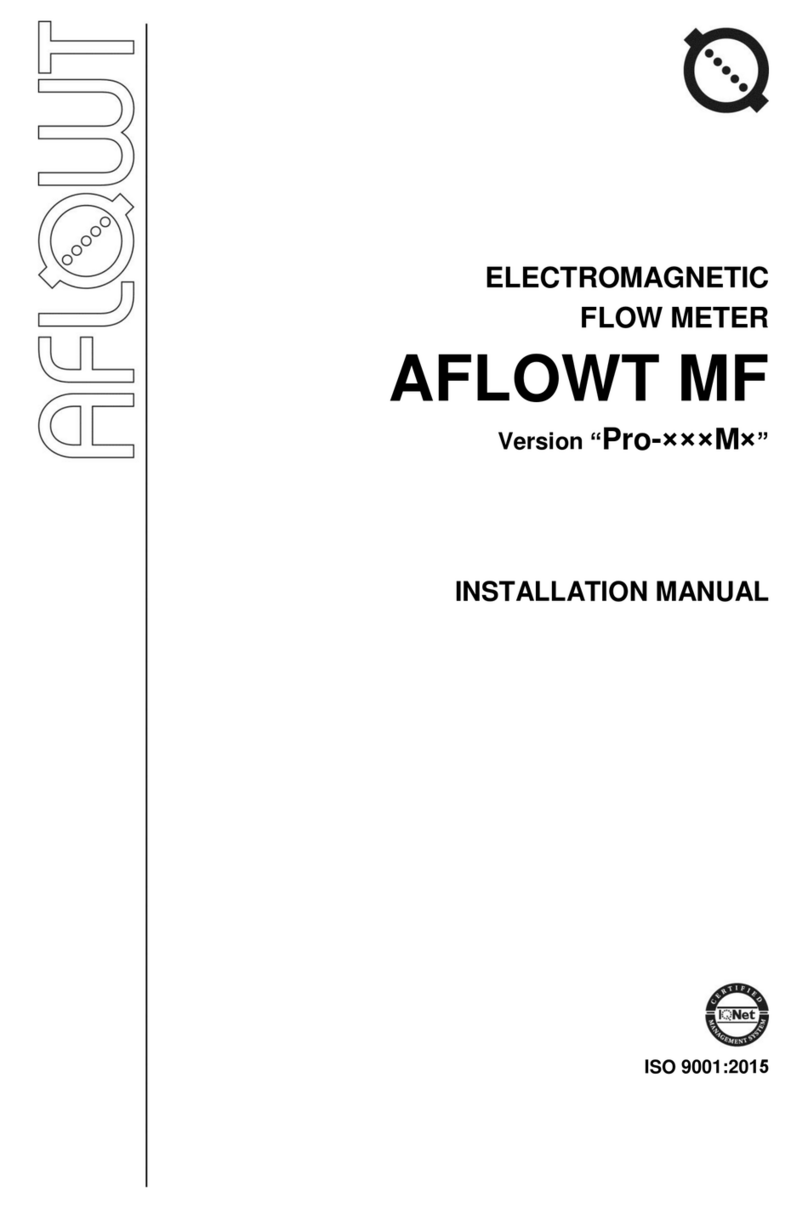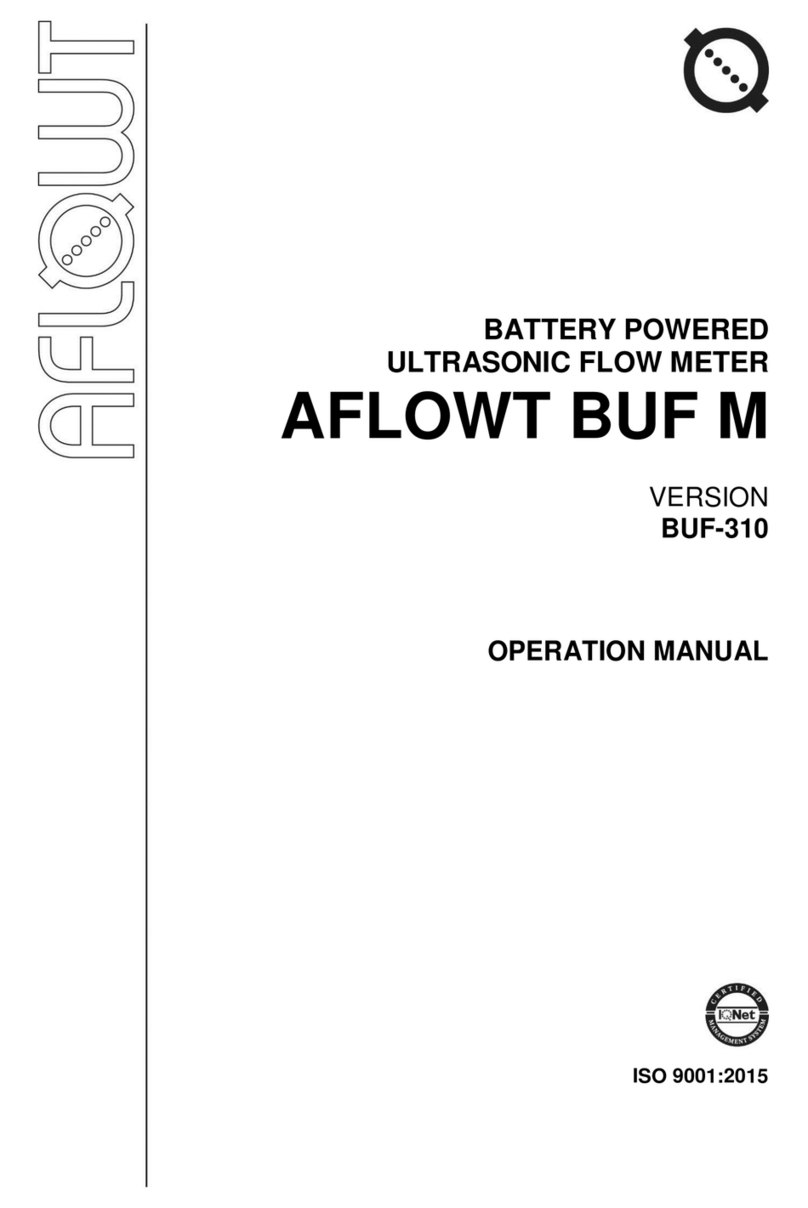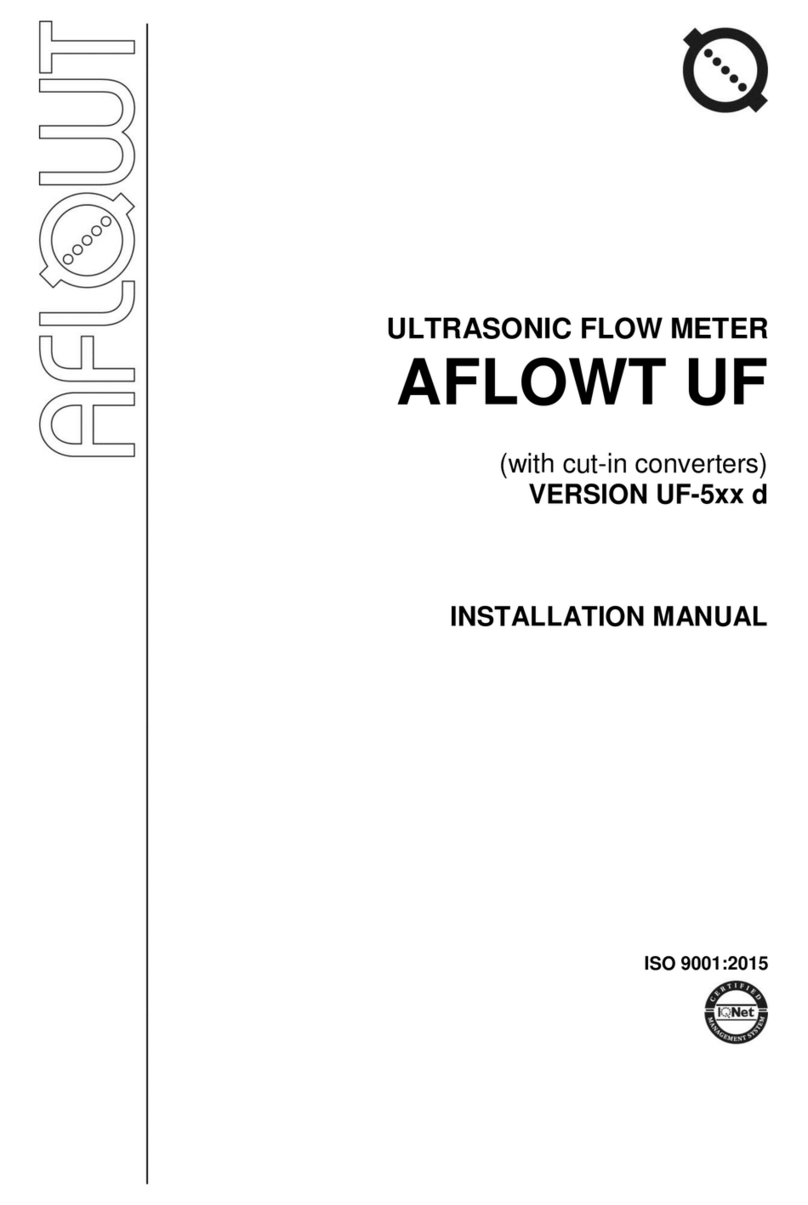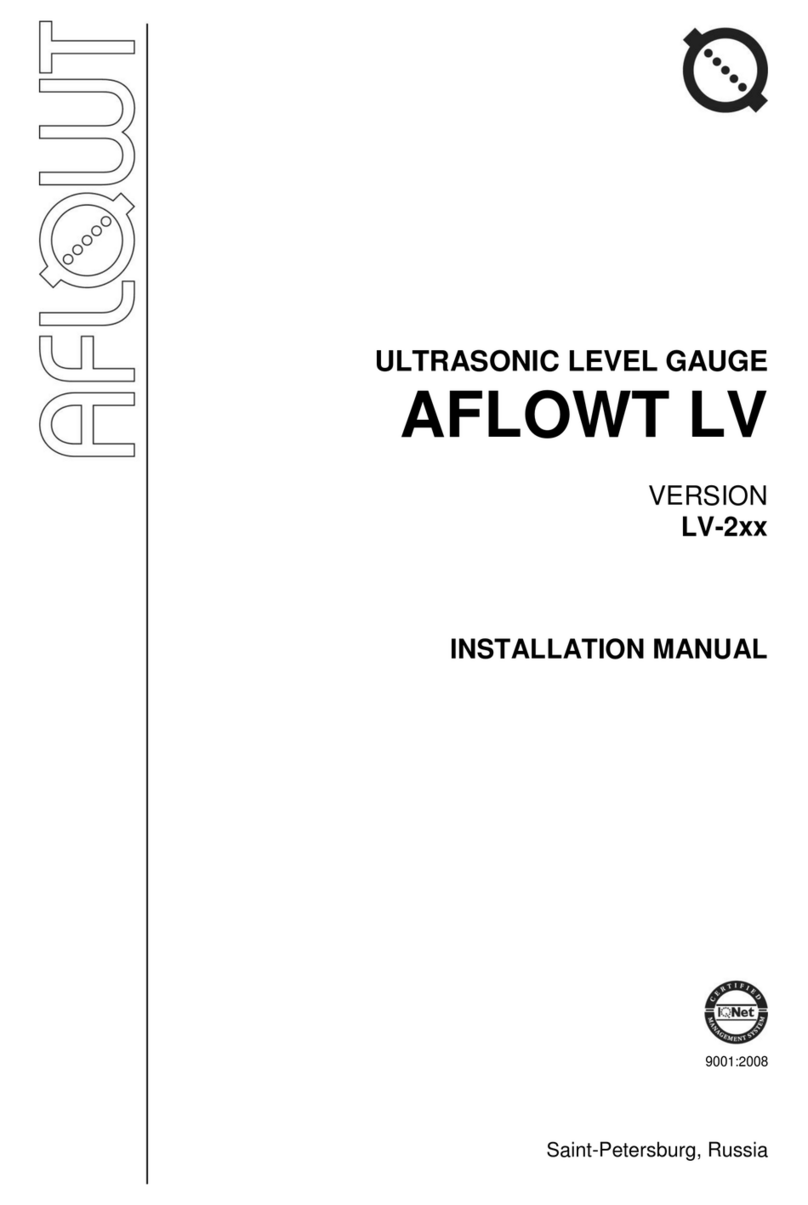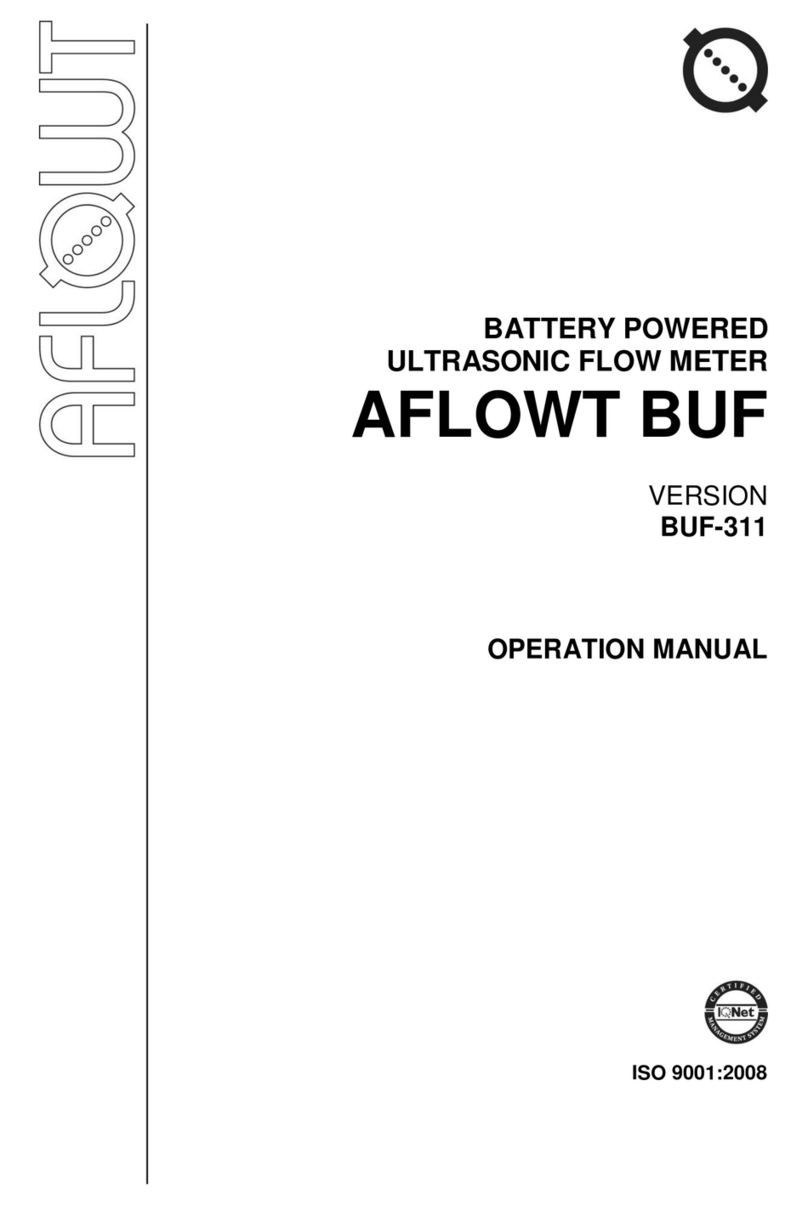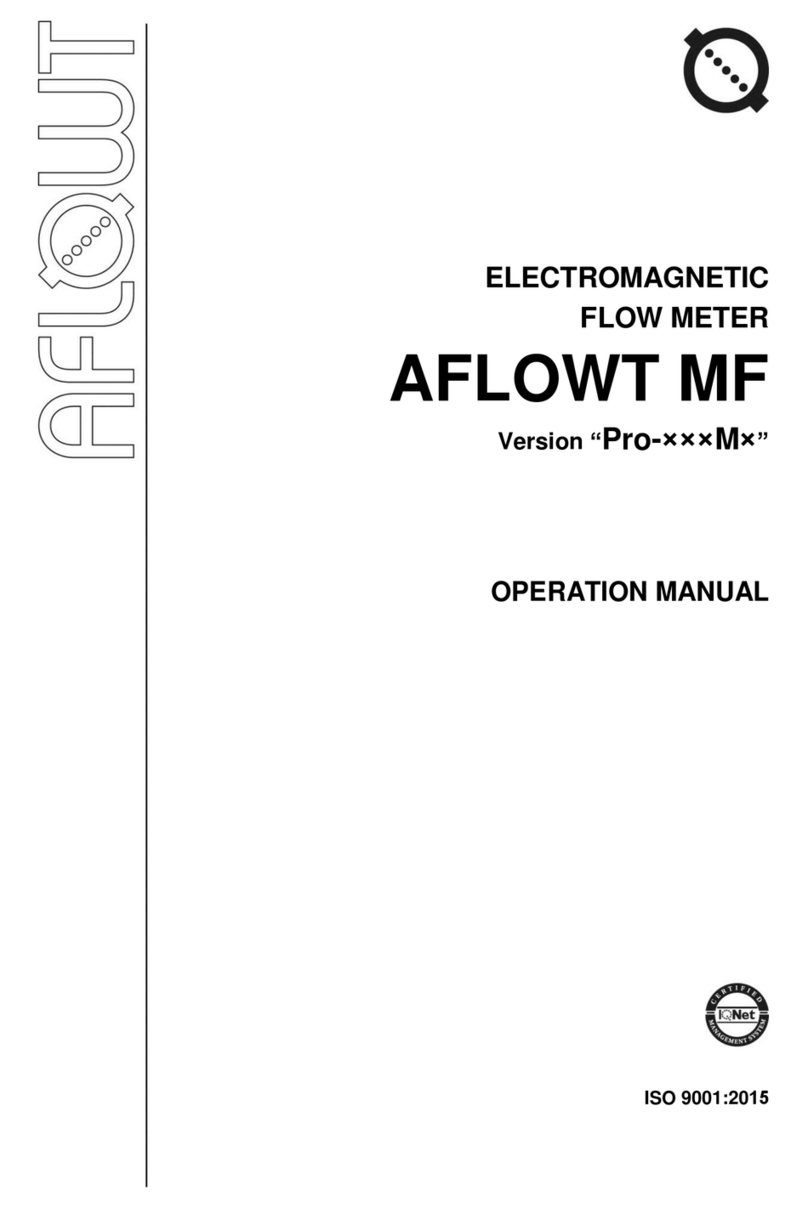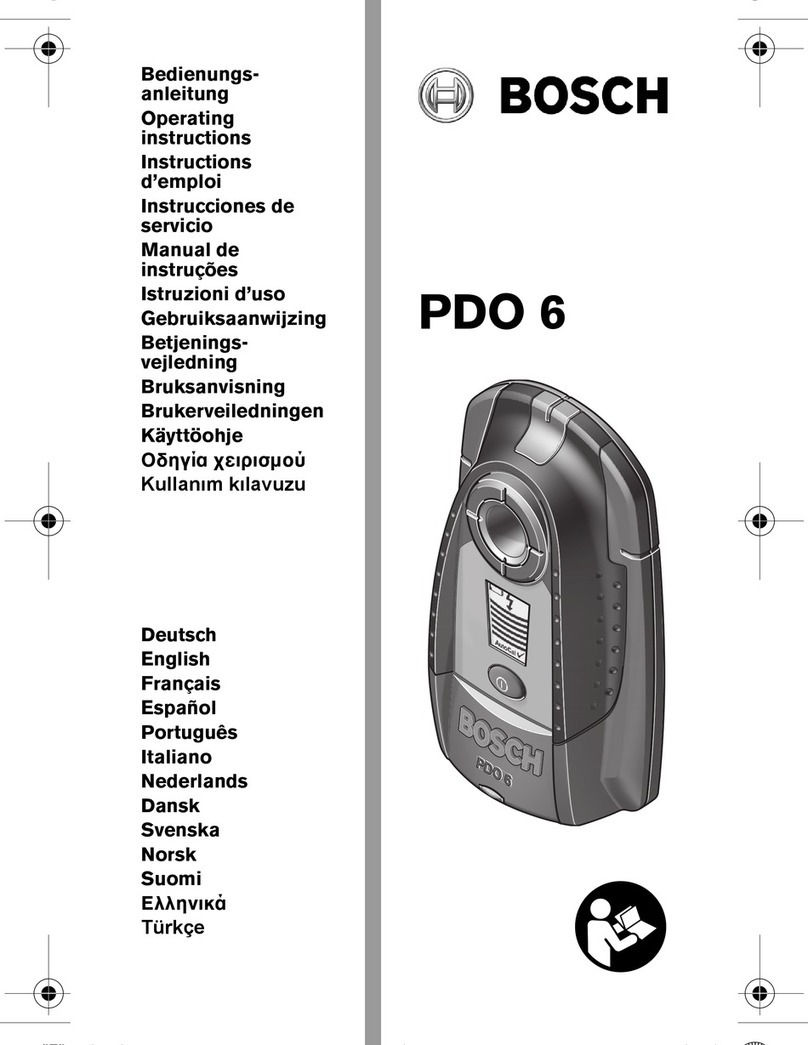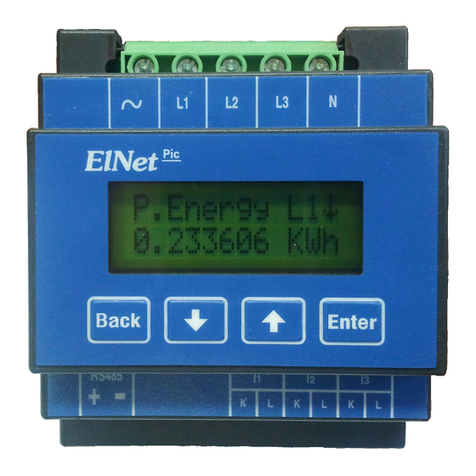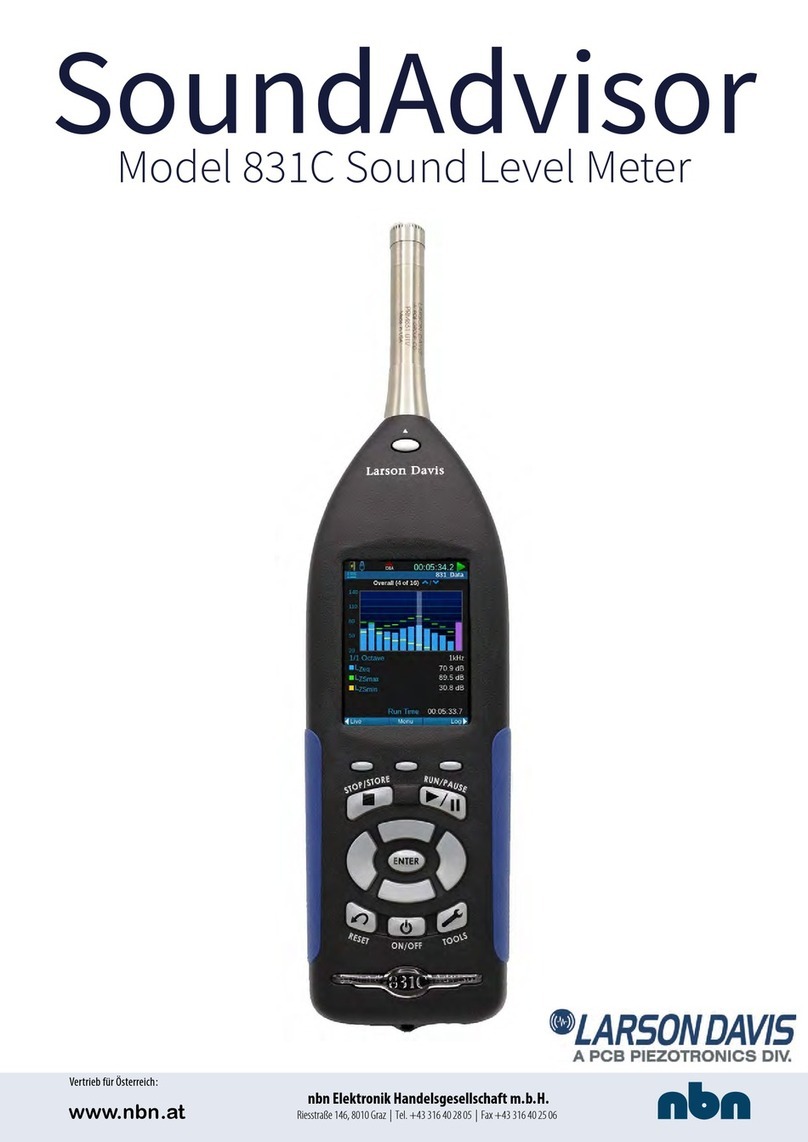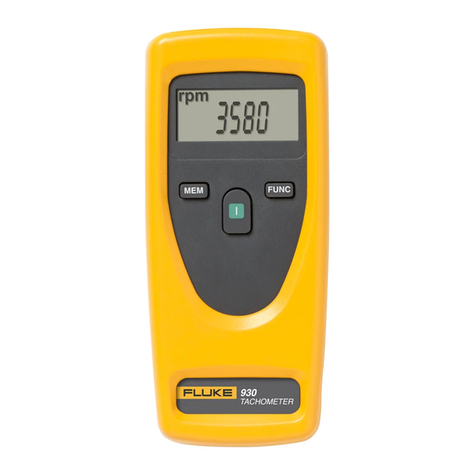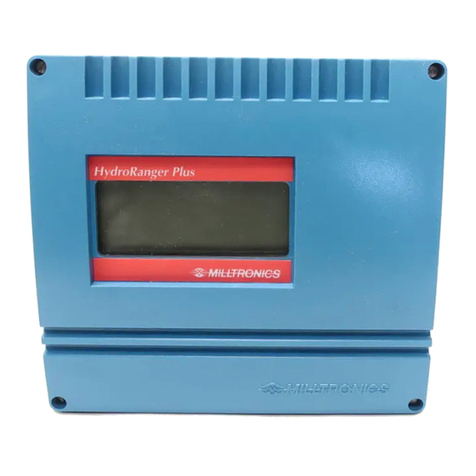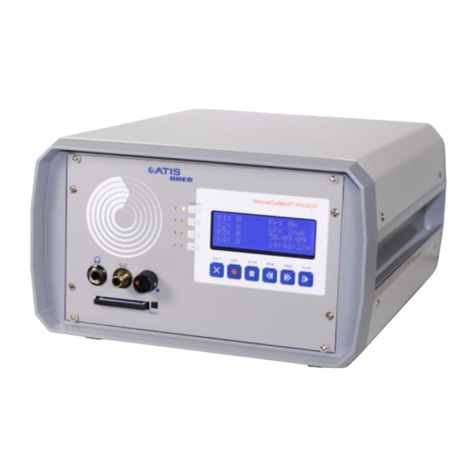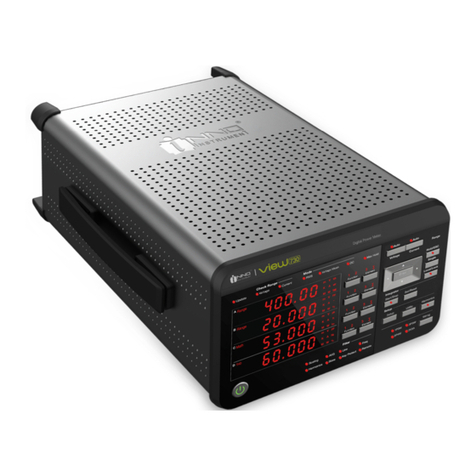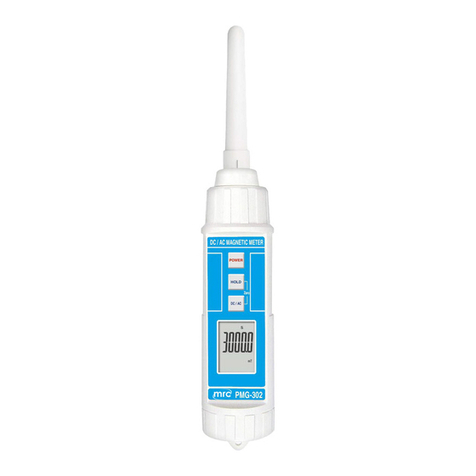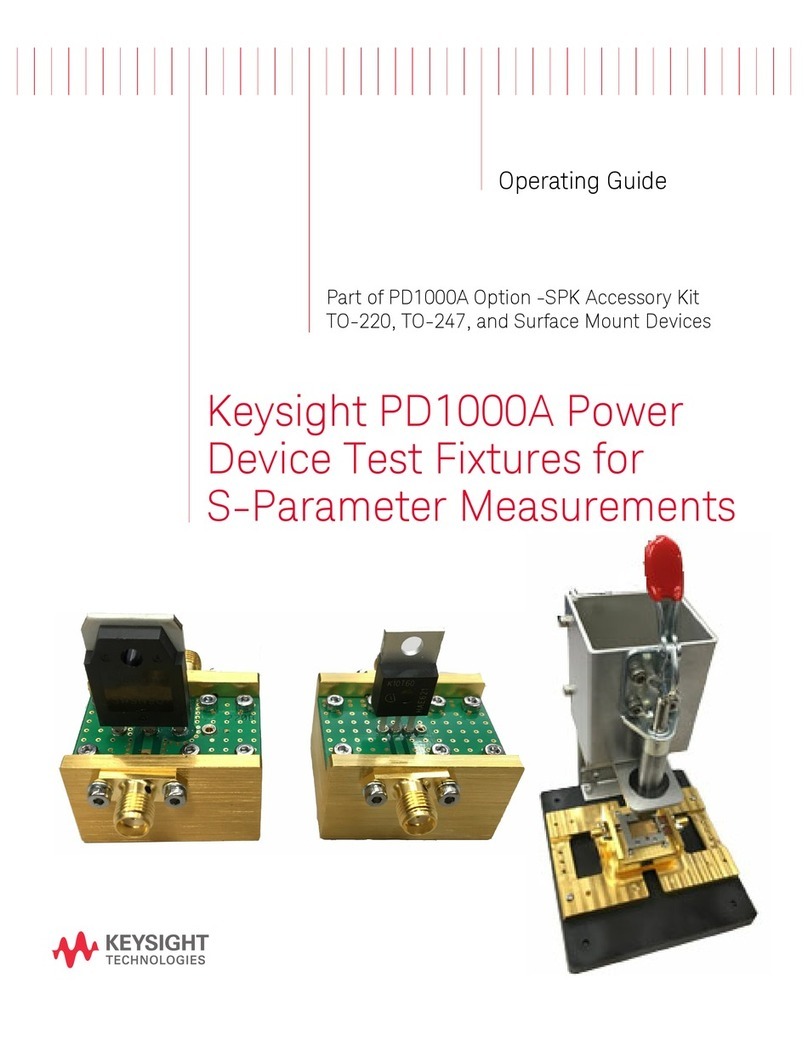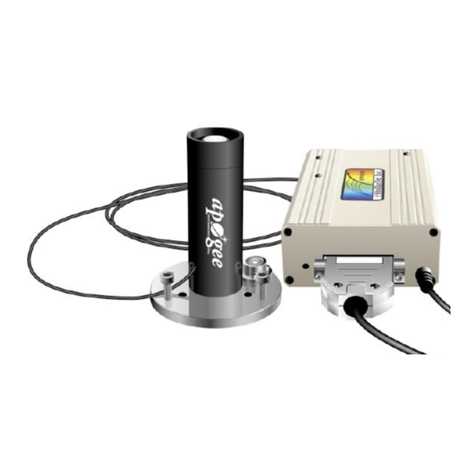AFLOWT UF-5 d Series User manual

ULTRASONIC FLOW METER
AFLOWT UF
(with clamp-on converters)
VERSION UF-5xx d
INSTALLATION MANUAL
ISO 9001:2015

2
CONTENTS Page
INTRODUCTION.....................................................................................................3
1. SAFETY INSTRUCTIONS...................................................................................4
2. MOUNTING PREPARATION..............................................................................4
3. MOUNTING REQUIREMENTS...........................................................................5
3.1. Requirements for Mounting the Electroacoustic Transducers......................5
3.1.1. General Requirements.......................................................................... 5
3.1.2. Placing the PEA pair for single-beam sounding .................................... 5
3.1.3. Placing the PEA pair for two-beam sounding........................................ 6
3.2. Length requirements for straight pipe runs...................................................7
3.3. Requirements for placing the Secondary measuring converter....................7
4. MOUNTING THE FLOWMETER.........................................................................8
4.1. Requirements for the pipeline at PEA mounting location .............................8
4.2. Defining the parameters of the measuring cut..............................................8
4.3. Mounting the Secondary Measuring Converter..........................................12
4.4. Procedures for mounting clamp-on PEAs ..................................................12
4.5. Wiring the Flowmeter .................................................................................14
5. START-UP PROCEDURE.................................................................................16
6. DISMOUNTING.................................................................................................16
APPENDIX A. Relative length of straight pipe runs...........................................17
APPENDIX B. Report on mounting and start-up procedure..............................19
APPENDIX C. Kinematic viscosity ratio of water...............................................22
APPENDIX D. Straightening vane design.........................................................23

3
The present manual covers procedures for on-site mounting and
dismounting of AFLOWT UF ultrasonic flowmeters of UF-510 d, -520 d,
-522 d models. In the course of work, also refer to manuals
"ULTRASONIC FLOW METER AFLOWT UF (with clamp-on
converters). Version UF-5xx d. Operation manual" part 1 and 2.
LIST OF ABBREVIATIONS
CS
DN
MC
PEA
- Secondary measuring converter
- Nominal diameter
- Measuring cut
- Electro-acoustic converter
NOTE. Words in the text marked in bold, for example, Settings cor-
respond to the items displayed on the flowmeter's screen.
CAUTION! It is highly recommended to study the Operation Manual
before starting to use the flowmeter.

4
1. SAFETY INSTRUCTIONS
1.1. The flowmeter should be mounted (dismounted) by the qualified tech-
nical staff:
- Certified for performing work of this type on the site where the flowmeter
is installed and authorized by the manufacturer
- Authorized to work with electrical installations up to 1000 V
- Upon reading all the instructions for the flowmeter and the auxiliary
equipment used for mounting and dismounting.
1.2. When working with the flowmeter, the dangerous factors are as follows:
- AC voltage (RMS value up to 264 V, frequency 50 Hz)
- Fluid temperature (up to 150 C)
- Other installation site-specific factors.
1.3. Prior to performance of works, make sure with the use of appropriate
equipment that no dangerous AC/DC voltage which may cause injury or
death is applied to pipeline section to be worked on.
1.4. In the course of mounting, start-up, commissioning and dismounting
works, it is strictly forbidden:
- To make connections to the flowmeter, switch over modes and replace
electronic components when the flowmeter is powered up
- To use defective electronic devices and electric tools or use them with-
out proper grounding.
1.5. Prior to connection of the flowmeter to the electric mains the CS module
is to be connected to the protective earthing trunk line (neutral earth-
ing).
CAUTION! Prior to connecting the protective earthing trunk
line make sure that the voltage is off.
2. MOUNTING PREPARATION
2.1. For on-site mounting of the flowmeter the following conditions should be
met:
- A free pipeline section should be available for mounting of the electroa-
coustic transducers (PEA)
- Availability of straight pipe runs of appropriate length upstream and
downstream the PEAs.
2.2. The flowmeter should be transported packed in the manufacturer’s box.
After the flowmeter has been moved to the mounting location from
a cold environment into a warm one (with ambient temperature above
zero), it shall be left to stand in the manufacturer’s box for at least
3 hours to make sure that no condensation remains inside.
When unpacking the flowmeter, check that the delivery package
contains all items specified in the Passport.

5
3. MOUNTING REQUIREMENTS
3.1. Requirements for Mounting the Electroacoustic
Transducers
3.1.1. General Requirements.
3.1.1.1. The following requirements should be observed on-site of PEAs mount-
ing:
- Liquid pressure in the pipeline and operation conditions must not be of
values that may facilitate gas (air) release and/or accumulation
- When the flowmeter is operated, the pipeline should be fully filled with
liquid
- Flow turbulence and pulsations are minimal.
The PEAs can be mounted into the pipeline horizontally, vertically,
or obliquely (Fig.1). The PEAs should not be placed at the upper point
of the pipeline or in the open-ended pipeline. The recommended loca-
tion (if applicable) is at the lower or uprising pipeline section.
Fig.1. Recommended locations of the PEAs.
3.1.1.2. It is recommended not to install PEAs in the upper or in the lower circu-
lar points of the pipeline cross-section.
3.1.2. Placing the PEA pair for single-beam sounding
When mounting PEAs on the diameter, they should be placed so
that the PEA longitudinal axis (the axis that runs through the PEA pair
along the pipeline axis) would make an angle with the vertical of
= 4510(Fig.2). The PEAs can be mounted horizontally.
Fig.2. Recommended locations of the PEA pair when mounting “on the di-
ameter” (single-beam sounding).

6
3.1.3. Placing the PEA pair for two-beam sounding
The clamp-on PEAs are mounted on the pipeline along the diame-
ter (Fig.3). In this case, the PEA pairs for Z- and V-configurations can
be placed either in different longitudinal planes or in the same plane.
The symbols in brackets correspond to the PEA pairs placed in the
same plane.
PEA1.1-PEA1.2 pair - 1st beam
PEA2.1-PEA2.2 pair - 2nd beam
Fig.3. Placing the PEA pairs “on the diameter” (two-beam sounding).
Fig.4 shows positioning of two PEA pairs in one plane.
for V-configuration the second PEA from a pair is shown in dashed line.
Fig.4. Location of PEA pairs for Z- and V-configuration in case of their
placement in one longitudinal plane (double-beam sounding).

7
3.2. Length requirements for straight pipe runs
3.2.1. For proper flowmeter’s operation, before the first and the last PEA with
respect to the flow direction, there should be straight pipe runs of corre-
sponding length with the DN equal to the DN of the pipeline. The “type”
installation minimum values of relative length of the straight pipe runs
for various PEA installation configurations and types of hydraulic re-
sistance are shown in Table A.1 of Appendix A.
The length of the straight pipe run L (mm) is calculated as follows:
DN×N=L
,
where N is the relative length defined in the number of DNs and speci-
fied in Table. A.1.
DN is the pipeline nominal diameter at the mounting location of
PEAs, mm.
CAUTION! While measuring the reverse flow, all the PEAs are in
upstream position, and the length of the straight pipe runs shall be de-
fined in view of this condition.
3.2.2. In case of mounting the straightening vane into the pipeline before the
measuring section (Appendix D), reduction of straight pipe run length is
possible at the inlet of the PEAs up to two times.
3.3. Requirements for placing the Secondary measuring
converter The following conditions should be observed at the site of CS loca-
tion:
- Operation conditions in accordance with the requirements of the Opera-
tion Manual
- Option for connecting the CS to the protective earthing trunk line (neu-
tral earthing)
- Free access to the CS.

8
4. MOUNTING THE FLOWMETER
4.1. Requirements for the pipeline at PEA mounting loca-
tion
4.1.1. The pipeline at the PEA mounting location must meet the following re-
quirements:
- Deviation of the pipeline inner diameter at the PEA mounting location
must not exceed 0.015 of the average pipeline inner diameter
- The pipeline section should not have any junctions, dents or any other
damages
- The straight pipe runs should not include devices or components up-
stream and downstream the PEA section that may disturb flow struc-
ture.
4.1.2. Prior to the flowmeter mounting operations, it is recommended to get
details on the medium (fluid flow range, temperature and fluid viscosity)
and get the pipeline certificate (standards for the pipe, material, dimen-
sions, operational terms and conditions).
For the flowmeter with clamp-on PEAs, it is recommended to esti-
mate the pipeline quality and PEA mounting location taking into consid-
eration the following: how ultrasonic vibrations would be transmitted and
whether the required level of received signal would be provided. For this
purpose, you can use the handheld ultrasonic flowmeter "AFLOWT UFd
PORT".
The inner pipeline surface at the PEA mounting location should be
covered with acoustically transparent corrosion- and sediment-resistant
protective coating.
4.2. Defining the parameters of the measuring cut
4.2.1. Prior to installation of PEAs on the active pipeline, it is necessary to de-
termine characteristics of the measuring cut (MC) –the pipeline section
intended for clamp-on PEA mounting.
4.2.2. To define the characteristics of the measuring cut, the measuring in-
struments and tools listed in Table 1 shall be used. Instead of the units
given in Table 1, you may use alternative measuring instruments and
tools provided that measurements of the corresponding parameters are
performed with the required accuracy.
Table 1
Tool name and type
Basic metrological characteristics
Metal rule
Division value, 1 mm
Vernier caliper
Fundamental measurement error 0.1 mm
Measuring reel
Division value 1 mm
Ultrasonic Thickness Gauge
Measurement error no less than 0.1 mm
Snap Gage
Division value 1 mm
The measuring devices shall function properly and, in case of
mounting the flowmeter at a metering station, they shall be timely cali-

9
brated and have the valid Calibration Certificates or corresponding
marks in the Equipment Certificates.
In addition to the above-mentioned measuring tools, it is necessary
to use the profiled angle, marking pencil for metal pipes and centre
punch.
All measurement and calculation results are registered in the corre-
sponding reports with 0.1 mm accuracy. The recommended form of the
report is given in Appendix B.
4.2.3. Defining the average value of outer diameter of the MC
The average value of MC outer diameter is calculated by averaging
measurements made on outer diameter (or outer circumference) for two
PEA installation cross-sections normal to the MC axis.
The location of cross-sections is marked on the pipeline according
to Fig.7.
12
Z-scheme
~DN
1 2
DN
DN
V-scheme
~0.5·DN
PEA PEA
Fig.5. Position of cross-sections for placing PEAs on the MC.
4.2.3.1. Defining the average value of MC outer diameter by measuring outer
circumference.
The MC is cinctured three times in each of the selected cross-
sections. The average circumference value is calculated in cross-
section 1 and 2:
3
L
=L ijcirc
avg1,2circ
∑
, mm,
where Lcirc avg1,2 is the average circumference value in cross-sections 1
and 2, mm;
Lcirc ij is the circumference value for the i-th measurement in the j-th
cross-section, mm.
The average MC circumference value is calculated as follows:
Lcirc avg:
2L+L
=L avg2circavg1circ
avgcirc
, mm.
The average MC outer diameter value D0 avg is defined as follows:
mm
The measurement and calculation results are registered in the re-
port.

10
4.2.3.2. Defining the average value of MC outer diameter by direct diameter
measurement.
Eight points are marked on each of the selected cross-sections of
the MC. The points are equispaced along each cross-section (Fig.6).
Fig.6. Location of points on the MC cross-sections.
Three measurements are made in the planes 1-5; 2-6; 3-7 and 4-8
of each cross-section. When measuring by a snap gauge, the fixed
feeler is placed directly on the point marked on the MC, and the moving
one is shifted to the facing point until the movable element achieves its
maximum position towards the surface of the MC. The measurements
can be carried out with the help of a vernier caliper and measuring reel.
The average value of MC outer diameter in cross-sections 1 and 2
is calculated as follows:
12
D
=D ij0
avg1,20
∑
, mm,
where D0 avg1,2 is the average value of MC outer diameter in cross-
sections 1 and 2, mm;
D0 ij is MC outer diameter for the i-th measurement on the j-th
cross-section, mm.
The average MC outer diameter value is calculated as follows:
D0 avg:
2D+D
=D avg20avg10
avg0
, mm.
The measurement and calculation results are registered in the re-
port.
4.2.4. Defining the average value of MC outer diameter in the longitudinal plane
if PEAs are installed “on the diameter”.
Measurement of MC outer diameter in the PEAs longitudinal plane
running through the PEA installation points and the MC axis is per-
formed with a snap gauge. In each of the selected cross-sections 1 and
2 on the MC (pipeline) the points intended for mounting of PEAs are
marked. Three measurements of outer diameter are performed in these
points for each cross-section. When measuring by the snap gauge, the
fixed feeler is placed directly on the point marked on the MC, and the
moving element is shifted to the facing point until the movable element

11
is in its maximum position towards the surface of the MC. The meas-
urements can be carried out with the help of a vernier caliper and
measuring reel.
The average value of MC outer diameter at the selected points in
cross-sections 1 and 2 is calculated as follows:
3
D
=D ijtr
avg1,2tr
∑
, mm,
Where Dtr avg1,2 is the average value of MC outer diameter in the PEAs
longitudinal plane for cross-sections 1 and 2, mm;
D0 ij is MC outer diameter in the PEAs longitudinal plane for the
i-th measurement on the j-th cross-section, mm.
The average MC outer diameter value in the PEAs longitudinal
plane Dtr avg is calculated as follows:
2D+D
=D avg2travg1tr
avgtr
, mm.
The measurement and calculation results are registered in the re-
port.
4.2.5. Defining the distortion factor of the acoustic base.
Based on results of measuring MC parameters, the distortion factor
of the flowmeter’s acoustic base Kbis defined as follows:
avg0
avgtr
bD
D
=К
.
The following condition is checked next:
0.985 Kb 1.015.
If the given condition is not satisfied, it is considered unsuitable to
mount the PEAs on the selected pipeline section and to use it for com-
mercial metering.
4.2.6. Measuring MC wall thickness.
Three measurements of MC wall thickness are performed with use
of the thickness gauge in points 2, 4, 6, 8 (Fig.9) of each cross-section.
The average value of MC wall thickness in cross-sections 1 and 2
is calculated as follows:
12
h
=h ijw
avg1,2w
∑
, mm,
where hw avg1,2 is the average value of MC wall thickness in cross-
sections 1 and 2, mm;
hw ij is the MC wall thickness for the i-th measurement on the j-th
cross-section, mm.
The average value of MC wall thickness is calculated as follows:
2h+h
=h avg2wavg1w
avgw
, mm.
The measurement and calculation results are registered in the re-
port.

12
4.2.7. Defining equivalent asperity of the MC.
The value of equivalent asperity of the MC inner surface dis de-
fined as per Table 2 and then registered in the report.
Table 2
Material
Pipe type and condition of the inner surface
d, mm
Brass, copper, aluminum,
plastics, glass, lead
New, without sediments
0.03
New, joint-free: - cold-drawn
0.03
- hot-drawn
0.1
- rolled
0.1
New, welded
0.1
With a slight film of rust
0.2
Rusty
0.3
Oil-coated: - new
0.05
- used
0.2
Galvanized: - new
0.15
- used
0.18
Cast iron
New
0.25
Rusty
1.2
With sediments
1.5
Oil-coated, new
0.05
Asbestos cement
With/without lining, new
0.03
Without lining, in normal condition
0.05
4.2.8. Defining kinematic viscosity ratio.
The kinematic viscosity ratio for water is defined according to Ap-
pendix C. To do this, it is necessary to determine the water temperature
range under operation conditions, calculate the average value of water
temperature and find the kinematic viscosity ratio for this temperature in
the table. The value is registered in the report.
For other liquids the value of the kinematic viscosity derived with
use of the viscometer.
4.2.9. The values of other parameters required for flowmeter’s operation are
defined after PEAs are installed on the pipeline. The procedure for de-
fining these parameters is described in the following sections of the
present manual.
4.3. Mounting the Secondary Measuring Converter
Fixing the CS and Secondary power source in vertical plane is per-
formed in accordance with the installation dimensions specified in the
Operation Manual.
4.4. Procedures for mounting clamp-on PEAs
4.4.1. The section of outer MC surface on which MC parameters were defined
is stripped to metal at cross-sections 1 and 2 (Fig.7). The stripped area
shall be of value enough to move PEAs along the stripped surface at a
distance equal to the PEA unit length in any direction.

13
When mounting PEAs according to Z- scheme, the stripped areas
are located on the opposite walls of the MC (pipeline) at a distance of
0.5 DN between the mid-points of the areas (along the MC axis).
4.4.2. PEAs are attached to the connectors of the corresponding CS channel
(Channel 1 –Channel 2) according to the flowmeter’s connection
scheme (Appendix B, part I of the Operation Manual) so that the corre-
sponding PEA is placed first relative to the flow direction and connected
to PEA1.1 and PEA1.2 terminals, and another one from the pair is the
second regarding the flow direction and connected to PEA2.1 and
PEA2.2 terminals.
4.4.3. The emitting surface of both PEA pairs is lubricated.
One unit from the PEA pair is mounted by seating it in the middle of
the stripped area as shown in Fig.7 and fixed with the mount clip (which
should be welded to the MC for the purpose) or by the clamp made of
flexible steel band. The position of the mount marks on the side walls of
this PEA is marked on the MC.
Fig.7. Positioning clamp-on PEAs on the pipeline (V-scheme mounting)
Another PEA from the pair is installed by seating it in the middle of
the second stripped area and fixed on the MC by the mount clip welded
to the pipeline or by the clamp made of steel band.
4.4.4. The datum axis of the device is measured –the distance between the
acoustic centers of the PEAs in the pair (mount marks on the side walls)
along the MC axis. When mounting according to Z-scheme, the MC is
sequentially cinctured with a measuring reel through the PEA1 and
PEA2 mount marks. At this time, it is necessary to draw the lines on the
pipe surface along the measuring reel up to intersection with the gener-
ator going through the opposite PEA (a conventional line on the surface
of the pipeline parallel to its axis). The distance between the half-arcs
along the generator lines are measured with the measuring reel and the
average value is calculated. The value is registered in the report.
The flowmeter automatically sets the required parameters of the re-
ceived signal. Automatically adjusted range is designed to respond to
considerable changes in both fluid characteristics (temperature, pres-
sure, acoustic transparency, etc.) and flow conditions.

14
4.4.5. To install the PEAs for two-beam flow sounding, the procedures accord-
ing to items 4.4.1-4.4.4 are performed for each PEA pair.
4.5. Wiring the Flowmeter
4.5.1. When connecting PEAs to the CS, it is necessary to provide that the el-
ements of the measuring channel (PEAs and communications cables)
be in correspondence with the characteristics of the channel.
PEA serial numbers with the measurement channel indicated are
specified in the flowmeter’s Passport.
The communications cable marking for the PEA pair is maintained
in similar labels with one or two white transverse bars.
The label color denotes reference to the measurement channel:
- Black –channel 1
- Grey –channel 2
One white transverse bar denotes that the communications cable
refers to PEA1, two white transverse bars denote that the communica-
tions cable refers to PEA2 from the pair of cables labeled in the same
color.
The PEA cable connectors and mounting locations can be labelled
"PEA1" and "PEA2", which will refer them to the corresponding PEA in
the pair.
4.5.2. The flowmeter’s power cable, CS-PEA connection cables, and CS-
external devices connection cables (if applicable) are laid in accordance
with flowmeter’s operating conditions.
4.5.3. Communications and network cables are fixed on the wall wherever
possible. The network cable is laid separately at a distance of 30 cm as
a minimum from other cables. To avoid mechanical damages, it is rec-
ommended to place all cables in metal tubes or sleeves.
IT IS FORBIDDEN to lay CS-PEA cables and external signal ca-
bles within proximity to power circuits. With presence of high-level elec-
tromagnetic interference (for instance, from a thyristor controller), IT IS
FORBIDDEN to lay the cables without putting them into properly
grounded (neutrally earthed) metal tubes or sleeves.
The metal tubes or sleeves shall only be grounded on one side –
on the CS side.
4.5.4. It is recommended not to coil the excessive cables.
4.5.5. Prior to connection, cut isolation from cable ends by 5 mm. The cables
are directed via cable glands and attached to the connectors according
to the Wiring diagram given in Appendix B of Part I of the Operation
Manual.
4.5.6 To prevent polyethylene insulation of the CS-PEA communications cable
from burning, the cable shall not be in contact with the heated pipeline.
The pipeline shall be thermally insulated at the points of contact, or you
may use another type of cable.
4.5.7. The RS-output of the flowmeter is connected to an external device. You
can use the standard 15 m Null-Modem cable as an RS-232 communi-
cations cable.

15
4.5.8. The need for protective grounding is determined by power supply and
environment conditions under which the flow meter is operated.
The protective grounding and earthing device should correspond to
the rules on design of power electric installations. Do not use the light-
ning protection system for grounding since in could result in device's
failure.
As a grounding wire, you must use a copper ground wire between
the flowmeter and grounding device. If mechanically protected, its
cross-section must be minimum 2.5 mm2. Minimum 4 mm2cross-
section is required for installations without protection.
The grounding conductor is connected to the earthing terminal of
the CS.

16
5. START-UP PROCEDURE
5.1. Before start-up you should check that flowmeter’s operation parameters
specified in the Passport correspond to data entered in the flowmeter
memory.
5.2. Parameters are entered according to the Operation Manual, Sections
2.1, Part II.
5.3. In case the flowmeter was supplied without the MS, and PEAs were
mounted on site, flowmeter’s zero offset dT0 and additional delay Padd
should be determined for each measurement channel or flowmeter
beam according to the method specified in the Operation Manual, Sec-
tions 2.2 and 2.3, Part II.
CAUTION! In case of replacement of any component of measure-
ment channel (CS, PEA, communications cables), parameters dT0 and
Padd should be determined anew.
5.4. Processing of measurement results is adjusted according to the Opera-
tion Manual, Section 2.4, Part II.
5.5. External devices (analog recorder, modem, etc.) are connected to the
flowmeter, communication system and flowmeter outputs are adjusted
according to the instructions given in Part II of the Operation Manual.
5.6. Current date and time are checked and set if necessary (see Section
2.5, Part II of the Operation Manual).
5.7. The device should be switched into the OPERATION mode (a jumper
should be removed from terminal J4). Terminal J4 should be sealed. If
necessary, two fixing screws are sealed from the front panel side.
If the parameters are set correctly, the flowmeter displays flowrate
measurement results.
5.8. Requirements for mounting location and operating conditions specified
in this operational documentation are based on the most typical factors
affecting flowmeter performance.
The external factors that cannot be foreseen, evaluated or tested
by the manufacturer during designing may exist or appear on site.
In this case such factors should be eliminated or flowmeter should
be placed in other location.
6. DISMOUNTING
To dismount the flowmeter, do the following:
- Switch off the flowmeter
- Disconnect cables leading to the CS (PEAs)
- Dismount the PEAs and CS.

17
APPENDIX A. Relative length of straight pipe runs
Table A.1 shows minimum values of relative length of pipeline
straight runs for installation of clamp-on PEAs depending on local hy-
draulic resistance types.
Table A.1
Type of local hydraulic
resistance
Relative length of a straight run, N, minimum
V-scheme
Z-scheme
1
2
3
10
15
3
5
10
15
3
5
10
15
3
5
10
15
10
15
Control valve
30
40

18
Table A.1 (cont'd)
1
2
3
Control valve
3
5
Fully-open ball valve
10
15
Pump
30
15
Pump
3
5
DN1 / DN 0.1
10
15
DN1 / DN 0.1
3
5
In case of various types of hydraulic resistance in the pipeline, the
length of a pipeline straight run related to the resistance nearest to the
PEAs should be no less than the value specified in the table, and the
distance from the PEAs to the other hydraulic resistances should be no
less than the value specified in the table for hydraulic resistance of this
type.

19
APPENDIX B. Report on mounting and start-up procedure
(recommended)
REPORT
on mounting and start-up procedure
for AFLOWT UF flowmeter, serial No. ________(sheet __ of ____)
UF-5__ d design version, channel No. _____
Beam 1 –PEA1.1 No. ______ / PEA1.2 No. _______ ;
Beam 2 –PEA2.1 No. ______ / PEA2.2 No. _______ ;
1. Site
______________________________________________________________
organization name, postal address, tel/fax
_________________________________________________________________
2. Site characteristics: DN of measuring cut _______ mm;
PEA installation diagram ____________ ; negative flow ________
Type of sounding _________, beam
Table B.1
Type of hydraulic
resistance
Length
of a straight run, m
To PEA1.1, 2.1
After PEA1.2, 2.2
3. MC outer diameter in the cross sections of PEA installation, D0 avg (fill in
table B.2 or B.3).
Table B.2
Circle perimeter
Cross section 1
Cross section 2
Measured value,
Lcirc ij, mm
1
2
3
Average value in cross section, Lcirc avg j, mm
Average value, mm
Lcirc avg = ; D0 avg = .

20
Table B.3
Outer diameter
Cross section 1
Cross section 2
Measurement plane
Measurement plane
1-5
2-6
3-7
4-8
1-5
2-6
3-7
4-8
Measured
value, D0 ij, mm
1
2
3
Average value
in cross section, D0 avg j, mm
Average value,
D0 avg, mm
4. MC outer diameter in the longitudinal plane of PEA installation, D tr avg (deter-
mined in case of PEA installation on the diameter)
Table B.4
Outer diameter
Cross section 1
Cross section 2
Measured value,
Dtr ij, mm
1
2
3
Average value in cross section, Dtr avg j, mm
Average value, Dtr avg, mm
5. Acoustic base distortion factor
avg0
avgtr
bD
D
=К
------------ =
0.985 Kb1.015
6. MC wall thickness, hw avg
Table B.5
Outer diameter
Cross section 1
Cross section 2
Measurement points
Measurement points
2
4
6
8
2
4
6
8
Measured
value, hw ij, mm
1
2
3
Average value
in cross section, рцavg j, mm
Average value, hwr avg, mm
7. Equivalent asperity of MC internal walls, d = ________ mm
8. Parameters of the medium.
8.1. Kind of liquid _____________________________________________
8.2. Temperature of liquid: maximum _________ C
minimum _________ C
average 0.5 (tmax + tmin) = _________ C
Table of contents
Other AFLOWT Measuring Instrument manuals
